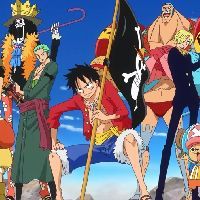Sharing is Caring

Shared universes are a long-time staple of American comics. Marvel's was built mostly from the ground-up in the 1960s; it incorporated some characters that had appeared in older comics (Captain America, Namor) but was mostly planned out so that each of their new characters from the Fantastic Four onward would coexist in the same continuity. DC's universe developed in a more convoluted fashion, with the relatively straightforward Justice Society crossovers in the 1940s eventually giving way to a complicated multiverse of different timelines that eventually grew so confusing it had to be scaled down to one universe in 1985's Crisis in Infinite Earths.
Now that Marvel's movie studio has pulled off the shared universe trick on the big screen, and Warner Bros. is attempting to do the same for their DC movies, every studio wants their own "cinematic universe." Sony's following up this summer's Ghostbusters reboot with an untold number of spin-offs, Universal's attempting to bring back their famous movie monsters (who had enough crossover movies in the past that the groundwork is already there), and Paramount's nefariously plotting to subject audiences to infinite variations on Bayformers.
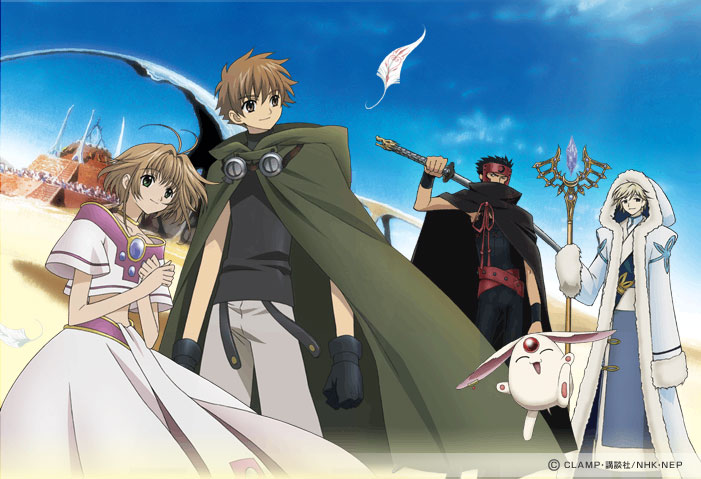 Image Source: Tsubasa Chronicle
Image Source: Tsubasa Chronicle
The shared universe concept doesn't hold the same prominence in manga and anime. Publishers aren't as laser-focused on a single genre like DC and Marvel are with superheroes for the idea to make artistic sense most of the time, and manga-ka aren't spending time consulting with each other on matching up continuity details. While crossovers do occasionally happen, it's not quite the same as a shared universe. Just because Shonen Jump licenses a bunch of characters for the Superstars fighting video game doesn't suddenly mean Death Note and Bobobo-bo Bo-bobo were ever conceived of as being from the same universe.
When there is more direct continuity between series, it's typically between series by the same manga-ka. Leiji Matsumoto has said his series are all taking place at different points in the same timeline, while Go Nagai's works have featured more direct connections. The most significant and most DC/Marvel-esque of these creator-driven shared universes in manga is definitely CLAMP's, which had its own Crisis on Infinite Earths-style event in the form of Tsubasa Chronicle.
Enter the Triggerverse
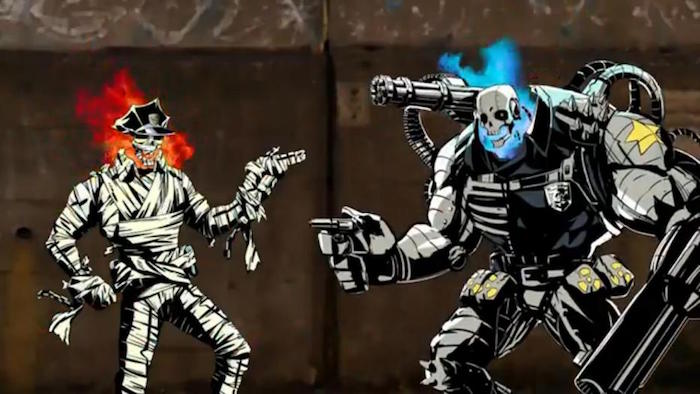 Image Source: Inferno Cop
Image Source: Inferno Cop
Trigger isn't a single creator like Go Nagai or specific group of creators like CLAMP. They're a studio where different directors take on different projects while sharing much of the same staff and a similar creative sensibility. Most of their anime series are original so they have greater control over the licensing. On top of that, they're a bunch of huge American pop culture geeks. If any studio was going to try and do the equivalent of a Marvel-style shared universe in anime, it would be them. At AnimeNEXT 2015, they tested the waters in perhaps the most ridiculous way possible. They made a 2 episode special that was a crossover between Inferno Cop...
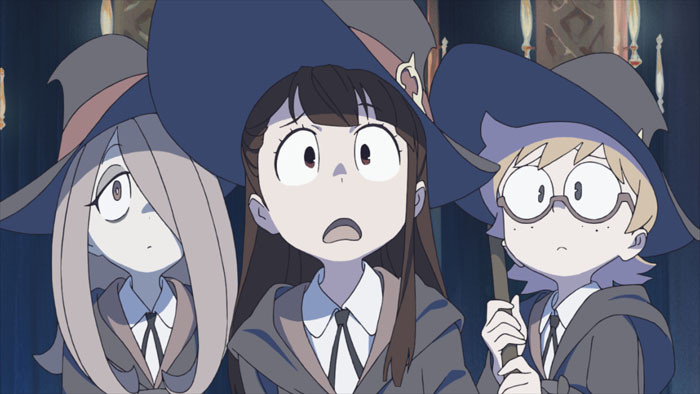 Image Source: Little Witch Academia
Image Source: Little Witch Academia
...and Little Witch Academia that was imaginatively titled Inferno Cop Specials.
Yeah. That's a thing that happened.
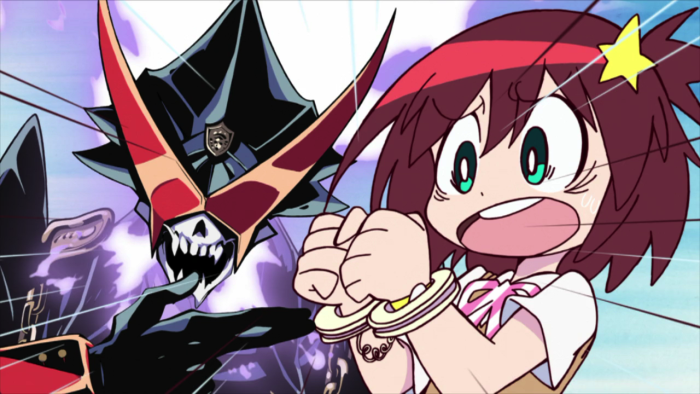 Image Source: Space Patrol Luluco
Image Source: Space Patrol Luluco
However, a one-off joke crossover does not a shared cinematic universe make. But a whole series connecting every original production Trigger's made is a whole different matter entirely. Space Patrol Luluco may go down in history as the series that birthed the "Triggerverse". Right from the start, it was announced the series shared a universe with Inferno Cop.
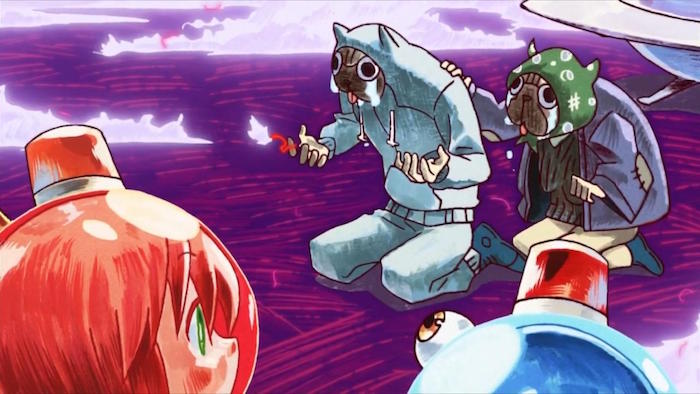 Image Source: Space Patrol Luluco
Image Source: Space Patrol Luluco
But Luluco doesn't just cross over with Inferno Cop. It crosses over with every original Trigger series, from Kill la Kill...
 Image Source: Space Patrol Luluco
Image Source: Space Patrol Luluco
...to Little Witch Academia...
 Image Source: Space Patrol Luluco
Image Source: Space Patrol Luluco
...to even Sex and Violence with Machspeed. (Haven't heard of that last one? It was Hiroyuki Imaishi's Animator Expo short. You can see it here for now if you're curious, but fair warning: it's Imaishi at his crudest, loudest, and most unhinged)
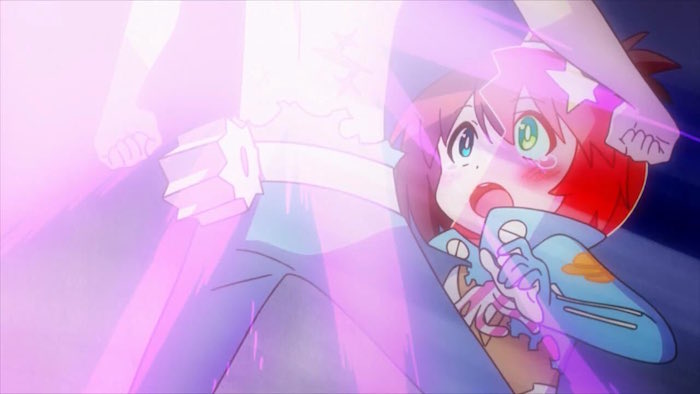 Image Source: Space Patrol Luluco
Image Source: Space Patrol Luluco
Seeing Nova with Kiznaiver scars in episode 12 completes it: aside from possibly a few more Animator Expo shorts, every original Trigger anime now shares the same universe (Trigger's adaptations aren't included in this universe for understandable legal reasons, as fun as it might be for Luluco to face down Ninja Slayer).
So Now What?
So the various Trigger series share the same universe. If they want to include their old characters in new and completely different stories, they've set a precedent that makes it possible, and there's certainly fun to be had with that. But is it the most fruitful artistic direction to be taking? Much of the appeal of following Trigger as a studio so far has been - while there are certainly shared artistic sensibilities running through their works - how their content varies dramatically from project to project. In contrast, shared universes often encourage greater conformity within those universes. Furthermore, relying too heavily on continuity between different series can run the risk of the content becoming too esoteric, too difficult for newcomers to follow, requiring Crisis-style reset events.
Fortunately the way Trigger's universe has been set-up in Luluco makes it easy to avoid such pitfalls. Kill la Kill and Sex and Violence with Machspeed might exist in the same universe, but they're not from the same planet. Setting the different series on different planets, and preserving the various styles of the different series on these planets, eases any fears of increased stylistic conformity or continuity lock-out. Crossovers and shared storylines between series are made possible, but also unlikely for the purposes of most stories. So the shared universe is open to Trigger as a tool, one they can potentially benefit from but not one they're required to trot out for every story.


